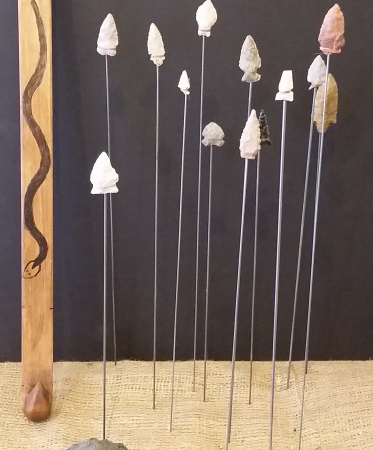MARCH 18, 2015
Cave Creek Museum presents “What’s the difference between an arrowhead versus a projectile point?”
 What regular people call arrowheads, archaeologists typically call “projectile points” because stone, wood, bone, antler, copper and other raw material types were used to put sharp points on the ends of all kinds of projectiles, not just arrows. These projectile points were used for hunting and warfare.
What regular people call arrowheads, archaeologists typically call “projectile points” because stone, wood, bone, antler, copper and other raw material types were used to put sharp points on the ends of all kinds of projectiles, not just arrows. These projectile points were used for hunting and warfare.
The “technology” that made the first stone points possible (invented in Africa by our ancient ancestors almost 400,000 years ago) involved knocking bits of stone off a hunk of rock to create a sharp point – archaeologists call this “flaking”. Eventually, these projectile points were attached to shafts of wood – short or long – to create spears, darts, and arrows. A huge advancement was the development of the atlatl, (pronounced “at-ul at-ul”), a throwing stick that allowed the hunter to fling the projectile point and shaft with great force and distance and with great accuracy.
Projectile points come in an amazing variety of shapes and styles, varying according to time periods, culture, and functions. And points were not just used as the heads of shafts – microscopic inspection of the edges of some ancient points show a wear pattern that indicates they were used in a sawing motion, like a knife!
Scientists have been able to use them to study the long-ago cultures that created them and it is not unusual for ordinary folk to find them in certain areas that were populated by ancient peoples, particularly after a rain.
Here in the Cave Creek-Carefree area, most projectile points found are fashioned from abundantly found local stone, like quartz and chert. More “exotic” materials, like obsidian, would have been obtained through trade with other tribes.
And which brings us back to our original question: “What’s the difference between an arrowhead and a projectile point?” Archaeologists believe ancient peoples first developed the throwing spear, then the atlatl, and finally the bow. Some might assume smaller points were used for hunting smaller prey, such as bird and rabbits while larger beasts, like long-horned sheep or bison required something larger, but now scientists think size had to do with how the point was used – was it thrown, flung, or projected?
In general, the scientists think the larger, finely made points are the oldest points, and are called spear points, used as the working ends of spears. The middle sized, fairly thick points are called dart points; these are in between arrows and spear points, and they were used with an atlatl. And tiny points are the most recent, used at the ends of arrows shot with bows. So they could be rightly called “arrowheads”!
Cave Creek Museum is a 501(3)c organization. Through your generosity and that of others, the museum is able to fulfill its mission. Call 480.488.2764, email [email protected] or donate online at www.cavecreekmuseum.org/donate-2. Located at the corner of Basin & Skyline off Cave Creek Rd. in Cave Creek.



